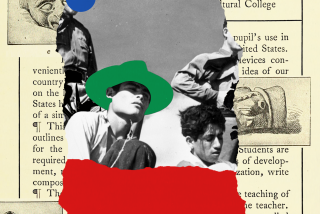‘Aggression’ Disputed : Textbooks-- Japan Splits on War Role
- Share via
TOKYO — Future historians will have to judge whether Japan’s role in World War II should be called aggression.
That is the view of the National People’s Council to Defend Japan--and of the textbook that it is offering Japanese high schools next spring.
“Historians believe that evaluations of history cannot be made until at least 100 years have passed,” Yuzo Kabashima, the conservative group’s secretary general, said in an interview.
In the council’s 258-page textbook, the “New Edition of Japanese History,” the word aggression appears only once--in a footnote. And it is there only because of yet another rerun of an imbroglio that has plagued the Japanese at home and their relations with their Asian neighbors since the end of World War II.
Education Chief Fired
This time, the controversy has led to the dismissal of a member of the Cabinet, the outspoken education minister, Masayuki Fujio. Prime Minister Yasuhiro Nakasone fired Fujio on Monday after Fujio, for the third time since taking office July 22, had criticized China and South Korea for complaining about the textbook.
In a magazine interview, Fujio asserted that the slaughter of tens of thousands of Chinese civilians by Japanese troops in 1937 was just “part of war” and blamed Korea for accepting colonization by Japan in 1910. The latter remark drew a diplomatic protest from the South Korean government and that led to his dismissal.
Once again, the controversy pits conservatives--people such as Fujio and the National Council’s members who seek to play down Japanese war brutality and put Japan’s aggression into a larger picture of international aggression in Asia--against leftists who seek to emphasize the brutality of Japan’s militarists and the evils of the capitalist system that they say produced it.
Left, Right Criticized
“Japanese ideologues on both the left and the right always seem to get things wrong,” the Japan Times complained in an editorial. Rightists, the newspaper said, seek to whitewash history to promote patriotism, while leftists distort it on behalf of pacifism.
All nations tend to view history from their own perspectives, and domestic disputes about what they should say are not uncommon either. But Japan’s textbooks appear to have attracted particular international attention, partly because of the long, and historically recent, period during which Japan inflicted suffering and death upon its neighbors. Although World War II lasted only four years in Asia and the Pacific, Japan’s intrusions into China and Korea began in the late 19th Century and continued until Japan’s surrender in 1945.
Most of all, though, because textbooks may not be used by schools unless the Ministry of Education approves them, they acquire an official aura, as if they represent the views of the national government.
Only four years ago, there was a diplomatic flap with both China and South Korea when the Education Ministry expunged the word aggression and substituted the word advance for invasion in textbooks describing Japan’s military moves against its Asian neighbors.
Those textbooks were written by authors with a Marxist point of view who attempted to play up Japan’s military brutality and aggression, which they attributed to the country’s capitalist system.
This time, however, there was a new twist. The ministry, which in the past has allied itself with the conservatives on behalf of softer descriptions of Japan’s military actions, was ordered into the “enemy” camp by Nakasone. Officials charged with screening textbooks were instructed to insert harsher language about Japan’s war role.
Nakasone acted to fulfill a promise the Japanese government made to China and South Korea in 1982 that, in screening history texts, it would “take into consideration the feelings” of Japan’s neighbors.
Controversy Revived
After the changes were made, Japan declared the issue closed, although both China and South Korea said they were still dissatisfied. Now, Fujio’s comments, and the protest from South Korea that they triggered, have reheated the controversy.
Seoul’s diplomatic note came just 12 days before Nakasone is scheduled to visit South Korea on Sept. 20-21. In the words of Korean Foreign Minister Choi Kwang Soo, the new statements “seriously aggravated the emotions of the Korean people.”
The National People’s Council, which was forced to accept 800 revisions in its original text, also remains unhappy. So, too, are moderate Japanese, disturbed by the precedent that Nakasone set in his intervention, and leftist Japanese, who complain that the Education Ministry should not have approved the book at all and that Nakasone should not have named Fujio to the Cabinet in the first place.
The National Council’s textbook was the first since the end of World War II in 1945 written by a self-avowed conservative group. Words like aggression and invasion were absent from the start.
“We consciously didn’t use the word aggression to refer to any country’s actions. . . . No evaluation of the war is offered,” said Kabashima, the general secretary.
He said the nine co-authors of the textbook did not intentionally avoid the word invasion, although it was not used to describe any Japanese military action. However, it was used for military actions by other countries.
127 Textbooks Examined
The “New Edition of Japanese History” was only one of 127 textbooks examined for use in all subjects in high school next year. Two were rejected entirely and all of the texts, most of them written from a leftist viewpoint, were revised, with an average of 302 amendments per book.
Much of the problem with the history book stemmed from the fact that it was the National People’s Council to Defend Japan that prepared it. The organization, a group of conservatives headed by Toshikazu Kase, a former ambassador to the United Nations, was formed in December, 1981, to push for revision of Japan’s postwar constitution, strengthen Japan’s defenses and “normalize” leftist-dominated education--goals that are anathema to most of the Japanese mass media, as well as to China and South Korea.
For all the controversy it has caused, the book appears reasonably objective. Its view of a key period of Asian history that set Japan on the road to conflict with Western nations in China and ultimately into World War II, for example, is far closer to the American view of history than Japanese Marxist authors offer.
The National Council’s book says that when Japan defeated China in an 1894-95 war, Western nations realized how weak “the sleeping lion of the Orient” was and moved quickly to force trade and territorial concessions from the Chinese in the early 20th Century.
Capitalism’s ‘Monopoly Stage’
One of the Marxist textbooks involved in the flap with China and South Korea four years ago, however, says the partitioning of China occurred because “capitalism had reached its monopoly stage” and “imperialistic nations”--including the United States--were seeking markets overseas.
The Education Ministry approved both interpretations.
In the National Council’s book, Japanese brutality is ignored but none of Japan’s military actions is overlooked. Nor is there any trace of romanticism in the book’s narration of how the military seized political control of Japan and the suffering the Japanese themselves endured.
Jiro Murao, a former chief textbook inspector of the Ministry of Education who supervised preparation of the textbook, said the book’s authors recognize that Japan caused great suffering and “untold casualties and deaths” in neighboring countries. He complained, however, that most history textbooks “criticize the past with the values of the present.”
“We tried to give understanding of historical facts as they occurred under the conditions of those times,” he wrote in a magazine article.
Justifying Aggression
The trouble was that too many justifications were offered for what foreign and Japanese critics alike view as aggression.
At several points, for example, the Chinese were portrayed as stubbornly refusing to compromise, thus provoking Japanese military action. Japan’s colonization of Korea is depicted as something that many Koreans agreed with, and opponents to it are described as “conservative factions.”
With China, the principal objection was to a reference--in a footnote only--to what American textbooks call “the Rape of Nanking.” After Japanese soldiers captured the then capital of China in December, 1937, tens of thousands of Chinese soldiers and civilians were killed. The dead included children and women, many of whom were raped.
But the new textbook, after three revisions, said that it has “not been scholarly determined” that the incident even took place. The final version says only that “news media reported many Chinese military and civilians were killed and injured by Japanese troops” with a parenthetical reference to “the so-called Great Massacre at Nanking.”
Wants More Proof
Kabashima, in the interview, said the National Council believes more proof of the massacre is needed. He pointed out that a group of former Japanese soldiers who were in Nanking (now spelled Nanjing) at the time are suing publishers of a leftist textbook for libel, contending that its report of the incident is false.
His statement reflects a rising tendency among conservatives to speak out against postwar taboos and against the view, introduced during the American occupation, that Japan bore sole responsibility for the war. Nakasone himself has encouraged the trend by calling for a “final accounting of postwar politics.”
Fujio also reiterated that theme, condemning the Tokyo War Crimes Tribunal for brainwashing Japanese into believing they had committed aggression unlike that of other nations in history. He described the tribunal as the “revenge of Western nations against the ‘yellow peril.’ ”
The complaints from South Korea have focused on omissions. South Koreans demanded an enumeration of all of the abuses they suffered during 35 years of Japanese colonial rule. The Education Ministry, however, ordered the authors only to insert one footnote about forcing Koreans to use Japanese names.
Comments on U.S.
The conservatives’ textbook is far more objective toward the United States than the average Japanese Marxist textbook, but it, too, takes swipes at America.
The key description of the outbreak of war with the United States, for example, depicts the Cabinet of Prime Minister Hideki Tojo, as late as 11 days before Pearl Harbor, still seeking negotiations to avoid a conflict with the United States, while the U.S. government was already “convinced that war (with Japan) was inevitable.”
The Ministry of Education approved that wording.
The textbook initially declared that America’s “failure” in the Vietnam War “completely removed the United States from the position (it had held in Japanese eyes) as an ideal country, and brought to the forefront the figure of ‘sick America.’ ” The ministry’s inspectors watered that down to read, “A cloud appeared on the position of leadership of the United States in the Free World.”
The success of the National Council’s venture will be determined by the number of its textbooks that high schools order, Kabashima said, indicating that sales of 50,000 would be encouraging. Sales will not be known until late September or early October.
He said the council decided to write its own textbook because, in its view, Japanese high schools have no history textbooks written from a conservative viewpoint. Indeed, the Education Ministry’s screening system itself was set up as an attempt to dilute the influence of Marxism in textbooks, he said.
Stranglehold on Sales
With many conservatives purged during the American occupation, the Marxist-imbued Japan Teachers Union established with leading textbook publishers a virtual stranglehold on textbook sales. The union’s links to textbook publishers are so tight that the National Council, Kabashima said, had to turn to a publisher that had never produced a textbook to get its book printed.
“Schoolteachers have never had a chance to select a textbook written from a conservative viewpoint (in the postwar period),” he said.
Former U.S. Ambassador Edwin O. Reischauer, an eminent scholar of Japanese society and history, has written that “more than Japanese themselves realize,” Marxist philosophy pervades the thinking of the Japanese, even conservatives, because of the Marxist influence in education from both textbooks and teachers.
Should the “New Edition of Japanese History” prove a success, the National Council will produce texts for both junior high and elementary schools, Kabashima added. Success also will encourage other conservative scholars to write textbooks, he predicted.
But as long as there is screening by the Education Ministry to give textbooks a stamp of government sanction, the attention that neighboring countries pay to what Japanese schoolchildren are taught is not likely to relax.
The success of the National council’s venture will be determined by the number of its textbooks that high schools order, Kabashima said, indicating that sales of 50,000 would be encouraging. Sales will not be known until late September or early October.
He said the council decided to write its own textbook because, in its view, Japanese high schools have no history books written from a conservative viewpoint. Indeed, the Education Ministry’s screening system itself was set up as an attempt to dilute the influence of Maxism in textbooks, he said.
More to Read
Sign up for Essential California
The most important California stories and recommendations in your inbox every morning.
You may occasionally receive promotional content from the Los Angeles Times.













